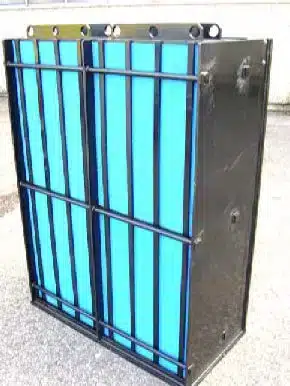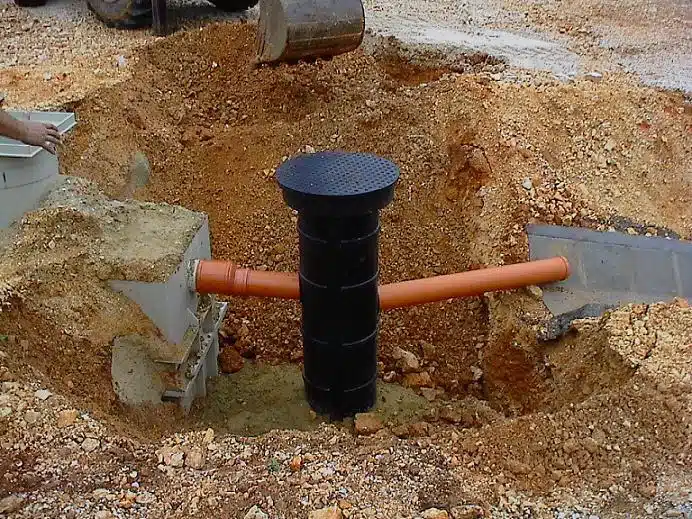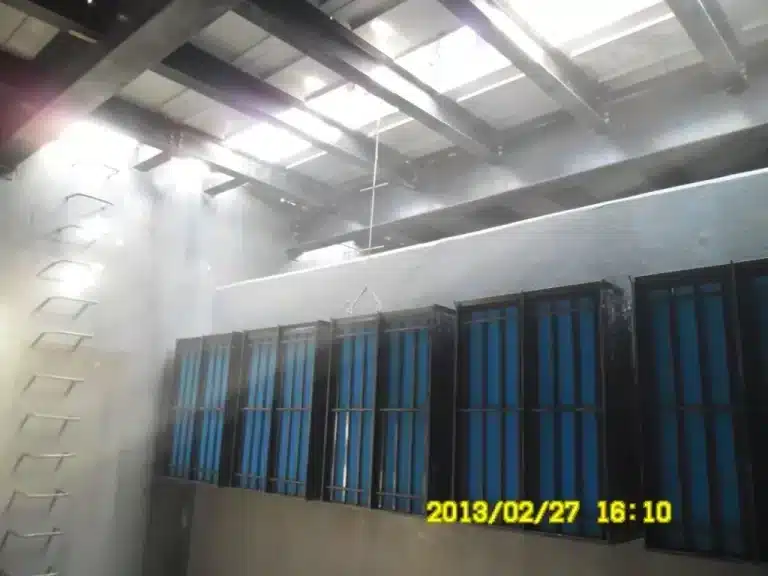In Illinois, a silent guardian works beneath our feet. The Illinois Below Ground OWS, or Oil Water Separator, is key to our underground water systems. These systems keep pollutants from our water. But how do they work and why are they crucial for our state?
The OilTrooper® SOCMP leads in oil-water separation in Illinois. It captures sand, oil, and grease before they reach public sewers. These systems protect our water from various sources, always working to keep our waterways clean.
Illinois has many options for these systems, like precast concrete and fiberglass. The AQS model is strong and reliable, made for tough environments.
Key Takeaways:
- Freytech Inc. Illinois Below Ground OWS systems are vital for protecting underground water resources
- OilTrooper® SOCMP is a leading interceptor system for oil-water separation
- These systems are used in various facilities, from car washes to industrial sites
- Multiple models are available, including concrete, fiberglass, and steel options
- Proper OWS implementation helps facilities meet strict discharge limits
Understanding Below Ground Oil Water Separators in Illinois
Below ground oil water separators (OWS) are key in Illinois for protecting the environment. They catch harmful substances before they can get into public sewers. Let’s look at what OWS do and why they’re important in Illinois.
Definition and Purpose of OWS Systems
OWS systems remove oil, grease, and sand from water. They use gravity and density differences to do this. This is important for keeping water clean and safe underground.
Importance in Environmental Protection
OWS systems are vital for keeping Illinois’ water safe. They stop oil spills from harming water and the creatures that live in it. Checking the water regularly makes sure OWS work well to keep the groundwater clean.
Illinois Regulations for Below Ground OWS
Illinois has strict rules for OWS. These rules set limits on what can be discharged to protect the water. Owners must keep up with maintenance and record how well OWS work. The state watches these systems to make sure they’re doing their job right.
Types of Below Ground OWS Available in Illinois
Illinois has many below ground oil water separator (OWS) systems for different needs. These systems are key in well construction and fixing groundwater issues, especially in areas with karst topography. Let’s look at the main types available in the state.
Fiberglass OWS Systems
Fiberglass OWS systems are liked for their light weight. They fit well in places needing regular tank pumping. Companies like Freytech Inc. offer underground fiberglass separators with sizes from 1,000 to 40,000 gallons. These systems work well in karst topography areas where the soil can be hard to work with.
Concrete OWS Systems
Concrete OWS systems are strong. They have many compartments and internal baffles for better oil and water separation. Concrete systems are perfect for well projects needing strong, lasting solutions.
Steel OWS Systems
Steel OWS systems come in single or double-wall designs. They meet high quality and safety standards, being UL-2215 and ULC-S656 listed. Steel systems are great for fixing groundwater issues. They can handle tough conditions and resist corrosion, making them a good pick for many Illinois sites.
Each OWS system has its own benefits. The best choice depends on your specific needs, site conditions, and local rules. Think about soil type, water table level, and how much capacity you need when picking an OWS for your Illinois project.
Key Features of Illinois Below Ground OWS
Illinois below ground oil water separators (OWS) have special features for better hydrocarbon separation. They can handle different kinds of underground conditions. They also work well and last a long time.
Many OWS units are made of fiberglass. This material is great at fighting corrosion. It makes the system last longer in various underground settings, perfect for Illinois.
Enhanced coalescing technology is a big deal in new OWS designs. It uses special M-shaped plates in a certain pattern. This setup helps oil droplets merge better, making the separation of hydrocarbons more effective.
OWS units also have removable plates for easy cleaning. This makes sure the system works well over time, even in tough places.
OWS systems in Illinois often have a UL 2215 Listing. This means they’ve been tested and meet high environmental standards. It gives owners and operators confidence in the system’s performance.
Some OWS systems come with warranties up to 30 years for structure and corrosion. This shows how durable and reliable these systems are in Illinois’s varied underground.
Installation Process for Below Ground OWS in Illinois
Installing a below ground oil water separator (OWS) in Illinois needs careful planning and execution. It involves several steps to make sure it works right and follows local rules. This guide will show you the main stages of installation, from getting the site ready to the final checks.
Site Preparation and Excavation
The first step is site preparation. This means surveying the area and marking where underground water systems are. Then, excavation happens, digging a hole big enough for the tank and for good groundwater management. The depth and width of the hole depend on the size of the OWS and the soil type.
Tank Placement and Connection
Once the site is ready, the OWS tank is put into the hole. It’s important to place it just right for the best system performance. Technicians then connect the tank to inlet and outlet pipes, making sure they’re sealed tight. This part is like building a well, needing precision and careful attention.
Backfilling and Finalizing Installation
After the tank is set and connected, it’s time to backfill. This means filling the hole around the tank with the right materials. Backfilling right is key for the tank’s stability and long life. The last steps include testing the system for leaks and checking all connections before starting the OWS.
Maintenance and Operation of Below Ground OWS
Keeping below ground oil water separators (OWS) in good shape is key to their success. Regular checks are crucial to make sure they work well. This means cleaning removable parts and keeping an eye on oil levels.
Many OWS models have maintenance alert systems. These tools help managers plan maintenance on time, avoiding problems before they start. This is vital for keeping the underground water flow safe.
Following the right flow rates is important for OWS. Only the right waste should go into the system to avoid contamination. This is especially true in places where monitoring the aquifer is a must.
Checking the water table regularly gives important clues about the OWS system’s performance. By watching for changes in the water table, operators can spot leaks or issues early. This keeps the environment safe and ensures the system meets legal standards.
Environmental Benefits of Proper OWS Implementation
Using oil water separators (OWS) in Illinois brings big wins for the environment. These systems are key to protecting the state’s diverse ecosystems and natural resources.
Protecting Illinois Waterways
OWS systems stop oil and grease from getting into Illinois’ waterways. This is super important in areas with karst topography, where pollutants can easily get into groundwater through porous limestone. By keeping oil and water apart, OWS systems help fix groundwater problems across the state.
Compliance with Regulations
Illinois has tough rules for OWS systems, like a 10 PPM limit for hydrocarbon discharge. Freytech Inc.’s OWS do even better, with a 5 PPM separation guarantee. This means they meet and beat the rules, offering extra environmental protection.
Long-term Ecological Impact
Using OWS well has big benefits for Illinois’ environment. It keeps aquatic ecosystems safe and guards groundwater. In places with special geology, like karst landscapes, the right OWS use is key. It helps keep underground water systems healthy and supports the environment for a long time.
Choosing the Right Below Ground OWS for Your Illinois Facility
Choosing the right below ground oil water separator (OWS) for your Illinois facility is key. You should consider the flow rate, tank size, and site layout. CSI offers UL 2215 listed OWS systems from 1,000 to 40,000 gallons. These systems are available in fiberglass, concrete, or steel.
The number of coalescer packs is also important. These packs improve hydrocarbon separation, making your OWS more effective. Freytech Inc.’s enhanced coalescing technology takes this even further. It ensures top-notch separation, which could be perfect for your facility.
Make sure the OWS fits with your current setup. The right choice meets Illinois regulations and protects the environment. By considering these factors, you’ll find an OWS that suits your needs and keeps your facility running smoothly.
These separators are crucial in storm water systems. They process runoff to meet the US EPA’s Clean Water Act standards. With effective oily water treatment, facilities protect the environment and dodge big fines.










